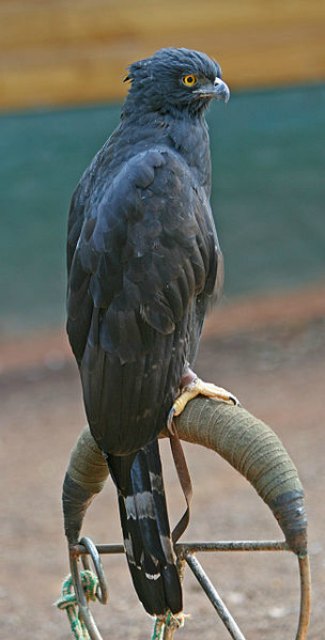Black Hawk Eagle - Spizaetus tyrannus
By www.birdphotos.com, CC-BY-3.0, via Wikimedia Commons
Family: Accipitridae
Genus: Spizaetus
Species: S. tyrannus
Subspecies: S. t. serus, S. t. tyrannus
Black Hawk Eagles are medium to large raptors that live in forests across parts of Mexico, Central America, and South America.
Physical Description:
Black Hawk Eagles are mostly black except for narrow white bars on underparts, thick gray bars on the tail and the underside of the wings, and some white on the crest. The eyes are yellow-orange and the feet are yellow with black claws. The wings are short and broad, and taper where they meet the body of the bird.
Juveniles are almost the complete reverse, with a white head streaked with black, white-tipped wing and tail coverts, and a dark-brown belly. The thighs are barred with white and brown, and the tail is gray with a white underside.
Their call is a repetitive series of whistles. Listen to a Black Hawk Eagle.
Size:
Length: 58-71 cm
Wingspan: 135-145
Weight: 1.09-1.12 kg
Habitat and Distribution:
Black Hawk Eagles live in dense and open forest, forest edges, lowland, foothills, and woodland in the Neotropic zone, from 21°N to 29°S. They are most common from 200-1,500 meters above sea level, but have been found as high as 3,000 m.
They are found in Mexico, throughout Central America, and in Brazil. There are approximately 20,000-49,999 individuals; their population is not thought to exceed 50,000.
Diet and Hunting:
They eat a variety of animals, including chachalacas, toucans, macaws, squirrels, bats, opossums, and reptiles such as snakes and lizards. They are also known to eat monkeys—their Brazilian name means “monkey-catching hawk”.
They perch in the forest canopy when looking for prey, and their food is often taken from the trees.
Reproduction:
The breeding season is from December-August. They reproduce slowly compared to other raptors, and are thought to nest only once every 2-3 years.
The nest is made of sticks, usually 110-140 cm in size, set 13-20 meters above the ground and supported by branches and vines in the canopy. A single white egg is laid and incubated for 42-45 days. It takes the chick around 70 days to fledge, but is dependent on its parent for several months after that; this may be the reason Black Hawk Eagles do not nest more often.
Conservation:
Due to habitat destruction, shooting, and other human disturbances, the population is thought to be decreasing. Black Hawk Eagles are currently listed as Least Threatened by BirdLife International.
Taxonomy:
Spizaetus tyrannus was formerly thought to be a color phase of Spizaetus oronatus (Ornate Hawk Eagle), but DNA studies proved that the two species are not even each others' closest relatives.
Subspecies:
There are two subspecies of Spizaetus tyrannus: S. t. serus, which lives from Central Mexico to Colombia, Trinidad, Paraguay, and northwestern and western Brazil, and S. t. tyrannus which lives in eastern and southeastern Brazil and Argentina.
Other Names:
Tyrant Hawk-Eagle, Gavião-pega-macaco (Brazilian), Sort Høgeørn (Danish), Tyrannenadler (Dutch), Must-tuttkotkas (Estonian), Ritarijalokotka (Finnish), Aigle tyran (French), Tyrannenadler (German), Spizaeto nero (Italian), Kurokumataka (Japanese), Svartskogørn (Norwegian), Wojownik czarny (Polish), Aguila azor negra (Spanish), Svart hökörn (Swedish).
Video of a Black Hawk Eagle:
References:
http://www.arthurgrosset.com/sabirds/blackhawk-eagle.html
http://www.avesderapinabrasil.com/spizaetus_tyrannus.htm
http://avibase.bsc-eoc.org/species.jsp?avibaseid=7680293AEE20F452
BirdLife International (2011) Species factsheet: Spizaetus tyrannus. Downloaded from
http://www.birdlife.org on 02/08/2011.
Global Raptor Information Network. 2011. Species account: Black Hawk-eagle Spizaetus tyrannus. Downloaded from
http://www.globalraptors.org on 2 Aug. 2011
BirdLife International 2009. Spizaetus tyrannus. In: IUCN 2011. IUCN Red List of Threatened Species. Version 2011.1.
www.iucnredlist.org. Downloaded on 02 August 2011.
http://www.mangoverde.com/birdsound/spec/spec30-233.html
Quintero, Ignacio, and Andrés Jácome. 2011. Black Hawk-Eagle (Spizaetus tyrannus), Neotropical Birds Online (T. S. Schulenberg, Editor). Ithaca: Cornell Lab
of Ornithology; retrieved from Neotropical Birds Online:
http://neotropical.birds.cornell.edu/portal/species/overview?p_p_spp=129396
http://www.planetofbirds.com/accipitriformes-accipitridae-black-hawk-eagle-spizaetus-tyrannus-2
Ferguson-Lees, James, and Christie, David A. Raptors of the World. Houghton Mifflin Company, 2001.
